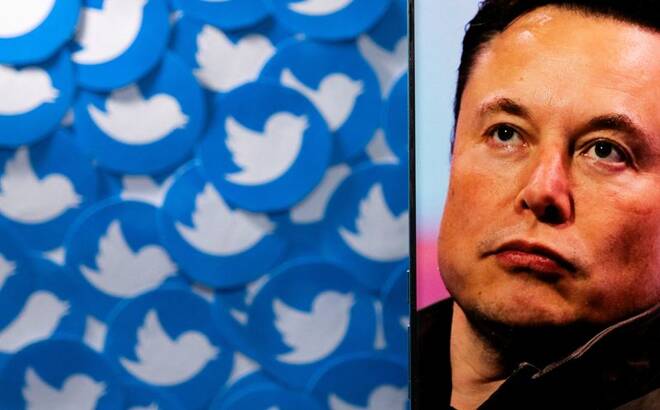Advertisement
Advertisement
Do spam bots really comprise under 5% of Twitter users? Elon Musk wants to know
By:
By Sheila Dang, Katie Paul and Dawn Chmielewski
By Sheila Dang, Katie Paul and Dawn Chmielewski
(Reuters) – Since 2013, Twitter has downplayed the spread of fake accounts on its platform, holding that “false or spam” accounts make up less than 5% of its user base even as independent researchers said the number could be three times higher.
That discrepancy could now affect the outcome of Elon Musk’s $44 billion cash deal after the billionaire tweeted on Friday that the takeover bid was “temporarily on hold” while he sought information about the number of phony Twitter accounts.
While this may be little more than a negotiating tactic by Musk, what is clear is that almost nothing is certain when it comes to how these accounts are defined or dispensed with, according to current employees and independent social media researchers.
The social media platform said in a May 2 public filing that fewer than 5% of its 229 million daily active users who are targeted with advertising are “false or spam” based on an internal review of a sample of its accounts. It did not specify how that figure accounted for the automated, parody and pseudonymous profiles permitted on the platform.
Twitter did not respond to requests for comment.
Researchers estimate that anywhere from 9% to 15% of the millions of Twitter profiles are automated accounts, or bots, based on one early study, from 2017, and more recent research from a firm that monitors online conversations.
“They have underestimated that number,” said Dan Brahmy, CEO of the Israeli tech company Cyabra that uses machine learning to identify fake accounts.
Cyabra estimates the percentage of inauthentic Twitter profiles at 13.7%.
Questions about the role bots play in spreading misinformation have dogged all social media platforms since 2016, when Russia meddled in the U.S. presidential election in a bid to boost Donald Trump’s candidacy and harm his opponent Hillary Clinton.
Meta, which owns competitor platforms Facebook and Instagram, likewise estimates that fake accounts represent about 5% of monthly active users on Facebook, according to its most recent data from the fourth quarter of 2021. Meta also estimates that about 11% are “duplicate” accounts in which a single user maintains more than one account, a practice considered acceptable on Twitter.
Twitter’s rules do bar impersonation and spam, meaning “fake” accounts are banned if the company determines that their purpose is to “deceive or manipulate others” by, for example, engaging in scams, coordinating abuse campaigns or artificially inflating engagement.
Clearing out spam
Over the years, Twitter has invested in clearing out spam accounts. In 2018, Twitter acquired a company called Smyte, which specialized in spam prevention, safety and security. Twitter removed “spammy and suspicious accounts” in a effort to improve the health of the platform, which caused its user base to drop by 1 million in July 2018 and its stock to tumble.
Researcher Filippo Menczer from Indiana University’s Observatory on Social Media said Twitter has gotten more aggressive at taking down these types of inauthentic accounts, though the nature of the threat is evolving and harder to quantify.
“Manipulation has also become more sophisticated,” with coordinated networks and so-called cyborg accounts controlled by both humans and software, Menczer said, adding that these bad actors can “flood the network and then delete their content to evade detection.”
Even if the numbers are actually small, bots can have an outsized impact, and a handful can have major influence in shaping online conversation, according to researchers.
One Carnegie Mellon University study analyzing the spread of COVID-19 falsehoods in 2020 found that of the top 50 influential retweeters, 82% were bots.
Inside Twitter, the measurement and detection of false or spam accounts is a complex problem that is not well defined or understood by many of the company’s own employees, three sources familiar with the matter told Reuters, speaking on condition of anonymity.
Twitter uses varying metrics and definitions to measure such accounts, which are also dependent on the company’s accuracy in detecting content that constitutes spam, one of those sources said. It also is challenged in its ability to accurately estimate the number of fake and spam accounts – and new accounts are always being created, the source said.
“Metric and data transparency at Twitter has been abysmal forever,” said another source, blaming disorganized management. “Plausible deniability has been the safest route for Twitter leadership.”
(Reporting by Dawn Chmielewski in Los Angeles, Katie Paul in San Francisco and Sheila Dang in Dallas; Editing by Kenneth Li and Will Dunham)
About the Author
Reuterscontributor
Reuters, the news and media division of Thomson Reuters, is the world’s largest international multimedia news provider reaching more than one billion people every day. Reuters provides trusted business, financial, national, and international news to professionals via Thomson Reuters desktops, the world's media organizations, and directly to consumers at Reuters.com and via Reuters TV. Learn more about Thomson Reuters products:
Latest news and analysis
Advertisement
